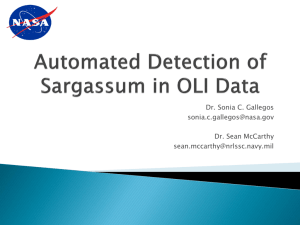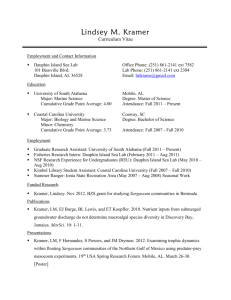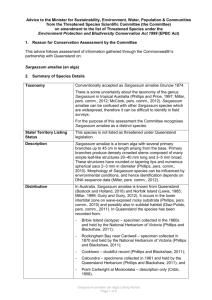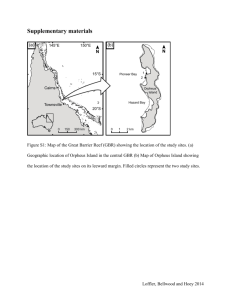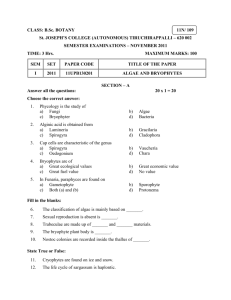(SEAS): An Investigation of the Loop System, Warm
advertisement
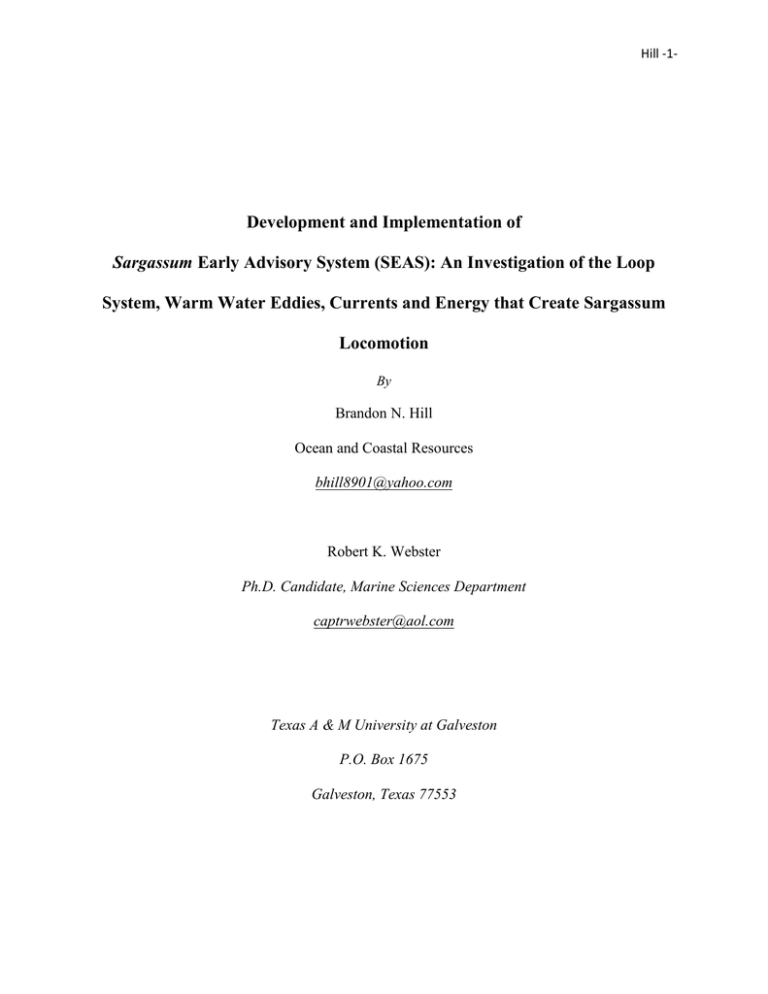
Hill -1- Development and Implementation of Sargassum Early Advisory System (SEAS): An Investigation of the Loop System, Warm Water Eddies, Currents and Energy that Create Sargassum Locomotion By Brandon N. Hill Ocean and Coastal Resources bhill8901@yahoo.com Robert K. Webster Ph.D. Candidate, Marine Sciences Department captrwebster@aol.com Texas A & M University at Galveston P.O. Box 1675 Galveston, Texas 77553 Hill -2- Abstract Sargassum Early Advisory System (SEAS) of Texas A&M University at Galveston (TAMUG) has compiled data that supports the existence of a loop system that flows from the Sargasso Sea, down into the Caribbean Sea, up into the Gulf of Mexico and then if not beached the sargassum will return again to the Sargasso Sea. Using The United States Geological Survey’s (USGS) Landsat imagery a large footprint of the ocean is now being monitored for sargassum. SEAS also uses tools such as National Oceanic and Atmospheric Administration (NOAA) and Atlantic Oceanographic and Meteorological Laboratory (AOML) Kriged Drifters, weather buoys and beach cameras to increase the accuracy and reliability of the predictive model. By working in conjunction with local schools and beach managers, SEAS aims to create a community that learns to value and efficiently use sargassum. Introduction The object of SEAS is three fold: to refine the details of the loop system that has proposed that sargassum takes throughout its life cycle, to increase the accuracy of the prediction of the sargassums’ travel through this loop system and to create an alternative disposal option of the sargassum after it has washed ashore on the beaches. The SEAS research team has uncovered and compiled evidence suggesting the existence of the loop system and that it is both wind shear and ocean current driven. This loop begins at the Sargasso Sea and is triggered by the Azores High Pressure System that oscillates between the Hill -3- West coast of Africa and the East coast of North America. The pressure change forces sargassum down into the Caribbean Islands where it is swept up in the Caribbean current and into the Gulf of Mexico. Here it can be torn off into tourbillions referred to as warm water eddies. These eddies are either taken back up by the Gulf Stream or spin until they run out of energy and break up, releasing the sargassum and debris that was trapped within them. If the sargassum was taken up by the Gulf Stream it travels swiftly up the coast of Florida and the east coast of the US, where it is pushed back into the Sargasso Sea by the sub-tropical currents of the North Atlantic Gyre. All along this system the sargassum can be run aground which greatly disrupts the tourism industry at these locations, for this reason sargassum is thought of as a nuisance. Methods SEAS uses many oceanographic techniques to deliver accurate predictions of the time, location and severity of sargassum landings. The SEAS predictive model is 90% accurate, forecasting sargassums' arrival up to two weeks out. The primary means of tracking the large sargassum mats is through USGS’s Landsat imagery. These USGS satellite images are used to seek out signs of sargassum moving through the system. Between the researchers the responsibility for eighty-one separate 31,820 square-kilometer images has been divided. The surveillance of these areas provides the system with a nearly foolproof net with which to catch the sargassum moving through the loop system. Weather buoys and beach cameras are also used for accurate monitoring of current weather conditions and confirmation of sargassum landings. NOAA and AOML’s historical databases of Kriged Drifter Data (http://www.aoml.noaa.gov/phod/trinanes/xbt.html) were accessed and used to increase the accuracy of the predictive model and add to the evidence in support of the existence of the loop Hill -4- system. These drifters have the capability to measure GPS position, water temperature and both vertical and horizontal velocity up to four times a day. Kriged Drifter Map NOAA, AOML Figure 1. This map shows the path that one drifter took while caught in the Caribbean current, Gulf Stream and several warm water eddies. It made landfall near Corpus Christi, Texas. Due to their size and weight drifters move through the ocean and run aground in a similar manner that sargassum would. This creates an accurate depiction of sargassum reaching the beaches. They are shaped like a box kite, providing ample surface area for the oceanic currents to act upon, they also will often have one or several bulb like floaters above the water that provide a sail to somewhat catch the wind. Sargassum travels similarly, stacking up in the water columns first few feet. The floating “mats” of sargassum are thick and are driven by the oceanic currents Hill -5- and Langmuir Cells while also extending vegetative structures above the water enabling wind to act upon them. More than thirty examples of drifters traveling along the proposed path have been collected. The compiled data has aided in the conformation of the timeline that is proposed along with the physical location and behavior of the loop system. Thousands of data points along with maps of the drifters’ path have been collected (see figure one). Videos were created using drifter maps that can be used to clearly show the paths that the drifters and sargassum can take. Thanks in large part to the drifters the probability of sargassum mats following one currents’ path over another, as well as the average rate that it takes sargassum to span a certain distance is now known with far greater accuracy. These drifters have revealed the importance of warm water eddies in the loop system. Warm water eddies are created when warm fast moving water in a current, such as the gulf stream is broken off from the mainstream of the current. The eddy breaks off along with any debris that might be caught up in it. These warm gyres are less dense than the water around them and therefore remain on top of the cooler water separated due to thermohaline differences. The warm water will continue to spin until its energy is expended at which point it will dissipate into the naturally occurring currents around it. This causes any debris that had been caught up within the eddy to be released. Sargassum is transported in this manner to the coasts where it lands. The researchers also see the effects of Langmuir circulation and transportation acting upon the sargassum. Langmuir circulation is thought to be a combination of Stokes Drift and wind shear driven current which blows across the surface of the water and creates cells of alternating upwelling and downwelling forming parallel areas of convergence and divergence. Hill -6- This is referred to as windrowing; it occurs nearly aligned with the wind direction however can vary up to 20 degrees from precise bearing. The wind must reach 3 m/s to create the Langmuir cells, however at wind speeds greater than 13 m/s the turbulent water will be too unstable to form the cells. These cells can be 4-6 meters deep and can be 10-50 meters apart, and the length can range from a few meters up to kilometers. There is evidence that sargassum uses the shear flow created by the wind and is forced into this flow by the destabilized vortices on either side. This pattern can be seen in satellite imagery from Landsat. Langmuir Circulation, Penn State Biol. 435, via www.powershow.com Figure 2. This image gives a cross section view of Langmuir Cells. The zones of convergence can be seen between A and B as well as C and D, while divergence is displayed between B and C. Hill -7- The inner workings of this process are still not fully grasped however, the effects of Langmuir circulation are essential to the life cycle and locomotion of sargassum. This especially is true in areas of “confused current” where the oceans thermohaline circulation and other driving forces are not strong enough to provide a steady stream of direction for the debris in the ocean. Wind driven motion can explain how the sargassum moves from the Sargasso Sea and heads towards the Northern and Eastern Caribbean Islands. The SEAS team has developed effective yet simple methods for spotting and correctly identifying sargassum through the use of USGS Landsat Imagery. Researchers look for irregularities in the water, caused by the sargassum mats, which are referred to as “slicks”. These are areas of irregular disrupted water adjacent to a mat which may be too small to be detected by the satellites RGB color array. Slicks appear as dark dendritic veins, through the water. The patterns seen in Landsat imagery match the effects of Langmuir circulation. Researchers often are tipped off by the seemingly random veins, which tend to occur at a stable state; eventually they will join together at 30° angles to form Y-junctions often pointing in the direction of the prevailing wind. Y shaped slicks are frequently seen in the satellite images that show sargassum closely approaching a landmass. Hill -8- Sargassum 05/18/2012, USGS, Galveston, path 25 Row 40 Figure 3. This USGS, Landsat image details the process by which the mean drift is found. A Y-shaped mat of sargassum can also be seen approaching the Texas shoreline. SEAS uses a self-adapted method of “set and drift” to account for the wind and ocean currents effect on sargassum while approaching the coastline. “Using predicted set and drift to arrive at the destination is the art of adjusting your course and speed to counteract the effect of the current.” (NOAA) This is what SEAS calculates as the sargassum drifts closer to land. Taking into account wind speed and direction along with the tide and currents SEAS can predict very accurately the arrival of sargassum on a beach. For the SEAS model, set and drift is used to Hill -9- measure cross currents, whether that is the wind or oceanic current. The wind may be the initial current while the oceanic currents may serve as the drifting force driving the sargassum from its expected landing point, or vice versa. These forces are averaged to find a mean drift which dictates the probable landing location and time frame. It is practice to take into account the wind speed and the duration that it has blown and mathematically factor this into the predictive model. On average, if the wind blows for 24 hours in a stable direction, then a 3% thrust of current wind speed at 10° shift to the right are implemented due to the Coriolis Affect in the Northern Hemisphere. SEAS research also involves finding an alternative use and disposal practice for the sargassum that ends up on the beaches. The method would center on the idea of creating a useable product from the sargassum. This new method would incorporate an understanding of the sargassums cycles and their causes. It would also hinge on understanding the value of sargassum as a natural part of coastline habitats. The SEAS team aims to provide an approach that allows sargassum to serve a constructive purpose even in its disposal. The SEAS project has already provided an invaluable tool in managing sargassum landings and has even greater potential in aiding the tourism industry as well as the public as a whole. Results The research supports the existence of a loop system in the Gulf of Mexico, Atlantic Ocean and Caribbean Sea as well as explaining the historically cyclical fashion in which sargassum episodes tend to occur. Oceanic currents in the Gulf, Caribbean and parts of the Atlantic Ocean drive the sargassum to and from its home in the Sargasso Sea. The other gaps in the system are filled in by wind shear driven Langmuir cells and warm water eddies. Through Hill -10- drifters, satellite imagery and ground-truthing the system has been tied together and supported by multiple mediums. Conclusion The SEAS team has focused a large part of its energy and resources on getting USGS’s Landsat information out to the public whether that would be a school or beach managers. High schools were specifically targeted as a way to reach out to the public. Students were invited to TAMUG’s computer laboratories and trained on the processes of analyzing Landsat images. In every instance the SEAS team was successful in training the students, so much so that they continued to analyze the images at school and sent in their products to the SEAS team. The students gravitated towards the project because they were able to work with real scientific data provided by USGS and relate the project to their firsthand knowledge of the sargassum they have grown up with throughout their lives. Beach managers were one of the primary end users of this data for the SEAS team. They were a target audience for the useful information that can be gleaned from analyzing the USGS Landsat data. They too picked up the how to use Landsat data fairly easily. After being introduced to the USGS images and shown how to look for sargassum they were able to do it for themselves. USGS Landsat Imagery has become as easy as checking the weather for these individuals and now plays a pivotal role in their decision making when it comes to beach management practices. SEAS utilizes Landsat Imagery to aid the local beach managers and communities in building a base of citizens who strive to solve problems in the most environmentally and economically savvy ways possible. SEAS aims to create a community where people no longer Hill -11- look at sargassum as an eyesore, but as a critical component in a multitude of environments. This mid-ocean oasis, sea turtle refuge, food source and eventually a vital part of our beach health should be appreciated rather than despised. This and more can be accomplished through what SEAS at Texas A&M at Galveston has proposed. Hill -12- Works Cited Langmuir Circulation. Digital image. Www.powershow.com. Penn State Biol. 435, n.d. Web. 30 Jan. 2013. <http://www.powershow.com/view/776e3YzYwY/Lake_Morphology_Affects_on_Circulation_powerpoint_ppt_presentation>. Li, Ming, and Chris Garrett. Cell Merging and the Jet/downwelling Ratio in Langmuir Circulation. Journal of Marine Research, 51, 737-769, 1993, 1993. Web. 30 Jan. 2013. O.B., Chubarenko, and Henning Bauder. "Dispersion of Material in a Shallow and Deep Basins." Электронный научный журнал «ИССЛЕДОВАНО В РОССИИ» 566 (n.d.): n. pag. Http://zhurnal.ape.relarn.ru/articles/2006/056e.pdf. Moscow Institute of Physics and Technology. Web. 30 Jan. 2013. Thorpe, S. A., Bodfryn, Glanrafon, Llangoed, and Anglesey. "LANGMUIR CIRCULATION." Annu. Rev. Fluid Mech. 36 (2004): 55-79. Annual Reviews. Web. 30 Jan. 2013. <http://www.annualreviews.org/doi/pdf/10.1146/annurev.fluid.36.052203.071431>. Trinanes, Joaquin A. "GTS&AOML's Data." GTS&AOML's Data. NOAA, n.d. Web. 30 Jan. 2013. <http://www.aoml.noaa.gov/phod/trinanes/xbt.html>.
